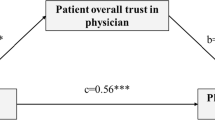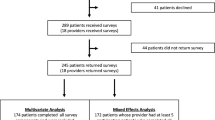Abstract
A diagnosis of breast cancer, whether the disease is early or advanced, can be devastating. With this in mind, constructive patient–physician relationships are essential to minimizing disease-related stress and anxiety, as patients undergo treatment and learn to cope with their diagnosis. Good communication skills are vital, and achieve measurable benefits, yet doctors receive very little training in communication. Patients may find it difficult to process large amounts of information, may not understand medical terminology, and can become confused or scared during discussions. They may need time to absorb information, and discuss it with friends and family, before treatment decisions are made. Patient awareness of treatment options is greater than ever, largely because of media exposure and the internet. Consequently, patients’ expectations and desire to be involved in treatment choice are increasing, although some patients still prefer to leave decision-making to their doctor. Information about potential side-effects and other treatment burdens is vital, if patients are to make truly informed choices. Knowing in advance what side effects may be encountered, and how to manage them, can also help to improve adherence to treatment, which is necessary for patients to gain the maximum benefit. Side effects that patients find most problematic often differ from those that most concern doctors. Individual patients have different needs and expectations that must be respected, but ensuring that they understand their diagnosis, and the expected benefits and potential risks of treatment, is the key to establishing a good therapeutic relationship and providing the best possible care.
Similar content being viewed by others
References
Fallowfield L, Jenkins V (1999) Effective communication skills are the key to good cancer care. Eur J Cancer 35:1592–1597
Fallowfield L, Lipkin M, Hall A (1998) Teaching senior oncologists communication skills: results from phase I of a comprehensive longitudinal program in the United Kingdom. J Clin Oncol 16:1961–1968
Taylor C, Graham J, Potts HW et al (2005) Changes in mental health of UK hospital consultants since the mid-1990s. Lancet 366:742–744
Fallowfield LJ (1995) Communication skills of oncologists. Trends Exper Med 5:99–103
Siminoff LA (1992) Improving communication with cancer patients. Oncology 6:83–87
Fallowfield L, McGurk R, Dixon M (2004) Same pain, less gain: potential patient preferences for adjuvant treatment in premenopausal women with early breast cancer. Eur J Cancer 40:2403–2410
Butler L, Bacon M, Carey M, Zee B, Tu D, Bezjak A (2004) Determining the relationship between toxicity and quality of life in an ovarian cancer chemotherapy clinical trial. J Clin Oncol 22:2461–2468
Fromme EK, Eilers KM, Mori M, Hsieh YC, Beer TM (2004) How accurate is clinician reporting of chemotherapy adverse effects? A comparison with patient-reported symptoms from the Quality-of-Life Questionnaire C30. J Clin Oncol 22(17):3485–3490
http://www.imaginis.com/breasthealth/statistics.asp. Cited 30 May 2007
Ries LAG, Melbert D, Krapcho M et al (2006). SEER Cancer Statistics Review, 1975–2004. National Cancer Institute, Bethesda, MD. Available via: http://seer.cancer.gov/csr/1975_2004. Cited 30 May 2007
Tracy GE (2004) Breast cancer–the disease many women fear the most. SDJ Med 57(4):148
Schenck-Gustafsson K (2007) Diagnosis of cardiovascular disease in women. Menopause Int 13:9–22
Wen KY, Gustafson DH (2004) Needs assessment for cancer patients and their families. Health Qual Life Outcomes 2:11
Cox A, Jenkins V, Catt S et al (2006) Information needs and experiences: an audit of UK cancer patients. Eur J Oncol Nurs 10:263–272
Jenkins V, Fallowfield L, Saul J (2001) Information needs of patients with cancer: results from a large study in UK cancer centres. Br J Cancer 84:48–51
Perry S, Kowalski TL, Chang CH (2007) Quality of life assessment in women with breast cancer: benefits, acceptability and utilization. Health Qual Life Outcomes 5:24–37
Degner LF, Kristjanson LJ, Bowman D et al (1997) Information need and decisional preferences in women with breast cancer. JAMA 277:1485–1492
Mandelblatt J, Kreling B, Figeuriedo M, Feng S (2006) What is the impact of shared decision making on treatment and outcomes for older women with breast cancer? J Clin Oncol 24:4908–4913
Deber RB, Kraetschmer N, Urowitz S, Sharpe N (2007) Do people want to be autonomous patients? Preferred roles in treatment decision-making in several patient populations. Health Expect 10:248–258
Wallberg B, Michelson H, Nystedt M et al (2000) Information needs and preferences for participation in treatment decisions among Swedish breast cancer patients. Acta Oncol 39:467–476
Janz NK, Wren PA, Copeland LA et al (2004) Patient–physician concordance: preferences, perceptions, and factors influencing the breast cancer surgical decision. J Clin Oncol 22:3091–3098
Lantz PM, Janz NK, Fagerlin A et al (2005) Satisfaction with surgery outcomes and the decision process in a population-based sample of women with breast cancer. Health Serv Res 40:745–767
Sabo B, St-Jacques N, Rayson D (2007) The decision-making experience among women diagnosed with stage I and II breast cancer. Breast Cancer Res Treat 102:51–59
Caldon LJM, Walters SJ, Reed MWR (2007) Changing trends in the decision-making preferences of women with early breast cancer. Br J Surg (in press). doi: 10.1002/bjs.5964
Beaver K, Booth K (2002) Information needs and decision-making preferences: comparing findings for gynecological, breast and colorectal cancer. Eur J Oncol Nursing 11:409–416
Katz SJ, Hawley ST (2007) From policy to patients and back: surgical decision-making for patients with breast cancer. Health Aff (Millwood) 26:761–769
Whelan T, Sawka C, Levine M et al (2003) Helping patients make informed choices: a randomized trial of a decision aid for adjuvant chemotherapy in lymph node-negative breast cancer. J Natl Cancer Inst 95:581–587
Keating NL, Guadagnoli E, Landrum MB et al (2002) Treatment decision making in early-stage breast cancer: should surgeons match patients’ desired level of involvement? J Clin Oncol 20:1473–1479
Fallowfield L (1997) Offering choice of surgical treatment to women with breast cancer. Patient Educ Couns 30(3):209–214
Fallowfield LJ, Hall A, Maguire P, Baum M, A’Hern RP (1994) Psychological effects of being offered choice of surgery for breast cancer. Br Med J 309:448–454
Al-Ghazal SK, Fallowfield L, Blamey RW (2000) Comparison of psychological aspects and patient satisfaction following breast conserving surgery, simple mastectomy and breast reconstruction. Eur J Cancer 36:1938–1943
Al-Ghazal SK, Fallowfield L, Blamey RW (1999) Does cosmetic outcome from treatment of primary breast cancer influence psychosocial morbidity? Eur J Surg Oncol 25:571–573
Al-Ghazal SK, Sully L, Fallowfield L, Blamey RW (2000) The psychological impact of immediate rather than delayed breast reconstruction. Eur J Surg Oncol 26:17–19
Atkins L, Fallowfield L (2006) Intentional and non-intentional non-adherence to medication amongst breast cancer patients. Eur J Cancer 42:2271–2276
Fallowfield L (2005) Acceptance of adjuvant therapy and quality of life issues. Breast 14:612–616
Peto R, Davies C, on behalf of the ATLAS Collaboration (2007) ATLAS (Adjuvant Tamoxifen, Longer Against Shorter): international randomized trial of 10 versus 5 years of adjuvant tamoxifen among 11500 women—preliminary results. Breast Cancer Res Treat 106 (suppl 1):abstract 48
Fallowfield L, Fleissig A, Edwards R, West A, Powles TJ, Howell A, Cuzick J (2001) Tamoxifen for the prevention of breast cancer: psychosocial impact on women participating in two randomized controlled trials. J Clin Oncol 19:1885–1892
Partridge AH, Wang PS, Winer EP, Avorn J (2003) Nonadherence to adjuvant tamoxifen therapy in women with primary breast cancer. J Clin Oncol 21:602–606
Cox AC, Fallowfield LJ (2007) After going through chemotherapy I can’t see another needle. Eur J Oncol Nurs 11:43–48
Chlebowski RT, Geller ML (2006) Adherence to endocrine therapy for breast cancer. Oncology 71:1–9
Fellowes D, Fallowfield LJ, Saunders CM, Houghton J (2001) Tolerability of hormone therapies for breast cancer: how informative are documented symptom profiles in medical notes for ‘well-tolerated’ treatments? Breast Cancer Res Treat 66:73–81
Cella D, Falowfield L, Barker P et al (2006) Quality of life of postmenopausal women in the ATAC (“Arimidex”, tamoxifen, alone or in combination) trial after completion of 5 years’ adjuvant treatment for early breast cancer. Breast Cancer Res Treat 100:273–284
Fallowfield L, Bliss JM, Porter LS et al (2006) Quality of life in the Intergroup Exemestane Study: a randomized trial of exemestane versus continued tamoxifen in postmenopausal women with primary breast cancer. J Clin Oncol 24:910–917
Whelan TJ, Goss PE, Ingle JN et al (2005) Assessment of quality of life in MA.17: a randomized, placebo-controlled trial of letrozole after 5 years of tamoxifen in postmenopausal women. J Clin Oncol 28:6931–6940
Trialists’ Group ATAC (2002) Anastrozole alone or in combination with tamoxifen versus tamoxifen alone for adjuvant treatment of postmenopausal women with early breast cancer. First results of the ATAC randomized trial. Lancet 359:2131–2139
Howell A, Cuzick J, Baum M et al (2005) Results of the ATAC (Arimidex, Tamoxifen, Alone or in Combination) trial after completion of 5 years’ adjuvant treatment for breast cancer. Lancet 365:60–62
Fallowfield L, Cella D, Cuzick J et al (2004) Quality of life of postmenopausal women in the Arimidex, Tamoxifen, Alone or in Combination (ATAC) Adjuvant Breast Cancer Trial. J Clin Oncol 22:4261–4271
Coombes RC, Kilburn LS, Snowdon CF et al (2007) Survival and safety of exemestane versus tamoxifen after 2–3 years’ tamoxifen treatment (Intergroup Exemestane Study): a randomised controlled trial. Lancet 369:559–570
Wengström Y, Aapro M, Leto di Priolo S, Cannon H, Georgiou V (2007) Patients’ knowledge and experience of adjuvant endocrine therapy for early breast cancer: a European study. Breast 16:462–468
Goss PE, Ingle JN, Martino S et al (2003) A randomized trial of letrozole in postmenopausal women after five years of tamoxifen therapy for early stage breast cancer. N Engl J Med 349:1793–1802
Gaston CM, Mitchell G (2005) Information giving and decision-making in patients with advanced cancer: a cancer systematic review. Soc Sci Med 61:2252–2264
Grunfeld EA, Maher EJ, Browne S et al (2006) Advanced breast cancer patients’ perceptions of desicion making for palliative chemotherapy. J Clin Oncol 24:1090–1098
Graydon J, Galloway S, Palmer-Wickham S et al (1997) Information needs of women during early treatment for breast cancer. J Adv Nurs 26:59–64
Financial disclosure/conflict of interest statement
The author of this article has no commercial associations (e.g., consultancies, stock ownership, equity interests, patentlicensing arrangements, etc.) that might pose a conflict of interest in connection with the submitted article. All funding sources supporting the work and all institutional or corporate affiliations of the author are acknowledged.
Author information
Authors and Affiliations
Corresponding author
Rights and permissions
About this article
Cite this article
Fallowfield, L.J. Treatment decision-making in breast cancer: the patient–doctor relationship. Breast Cancer Res Treat 112 (Suppl 1), 5–13 (2008). https://doi.org/10.1007/s10549-008-0077-3
Received:
Accepted:
Published:
Issue Date:
DOI: https://doi.org/10.1007/s10549-008-0077-3




